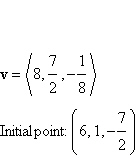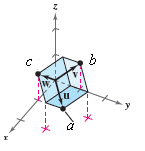Multiple Choice
Identify the
choice that best completes the statement or answers the question.
|
|
|
1.
|
Find the coordinates of
the point.
The point is located on the  -axis, seven units in front
of the -axis, seven units in front
of the  -plane. -plane.
a. |  , ,  , ,
 | b. |  , ,  , , 
 | c. |  , ,  , ,   | d. |  , ,  , ,   | e. |  , ,  , ,   |
|
|
|
2.
|
Determine the octant(s)
in which  is located so that the condition(s) is (are)
satisfied. is located so that the condition(s) is (are)
satisfied.

a. | Octant II | b. | Octants II, IV, VI, VIII | c. | Octants I, II, III | d. | Octants I, II,
III, IV | e. | Octants III, IV, VII, or
VIII |
|
|
|
3.
|
Find the midpoint of
the line segment joining the points.

a. | (  , ,  , ,  ) ) | b. | ( , ,   , ,  ) ) | c. | ( , ,  , ,  ) ) | d. | ( , ,  , ,  ) ) | e. | ( , ,  , ,  ) ) |
|
|
|
4.
|
Find the center and
radius of the sphere.

|
|
|
5.
|
Find the magnitude of v.

|
|
|
6.
|
Find the magnitude of v.
Initial
point: 
Terminal point: 
|
|
|
7.
|
Find the dot product of u and
v.

|
|
|
8.
|
The vector v and its initial point are
given. Find the terminal point.

a. | Terminal point is  . . | b. | Terminal point is
 . . | c. | Terminal point is  . . | d. | Terminal point is  . . | e. | Terminal point is  . . |
|
|
|
9.
|
The vector v and its initial point are
given. Find the terminal point.

a. | Terminal point is  . . | b. | Terminal point is
 . . | c. | Terminal point is  . . | d. | Terminal point is  . . | e. | Terminal point is  . . |
|
|
|
10.
|
Find the dot product of u and
v.
u = –6i + 3j –
7k, v = –6i + 9j + 2k
a. | –12i + 12j –
5k | b. | 49 | c. | –5 | d. | 36i +
27j – 14k | e. | 77 |
|
|
|
11.
|
The vector v and its initial point are
given. Find the terminal point.
v = 
Initial point: (7, 4,
0)
|
|
|
12.
|
Use the triple scalar product to find the volume of
the parallelepiped having adjacent edges u,v,and w.



a. |  cubic
units cubic
units | b. |  cubic
units cubic
units | c. |  cubic
units cubic
units | d. |  cubic
units cubic
units | e. |  cubic
units cubic
units |
|
|
|
13.
|
Use the vectors u and v to find  . .

|
|
|
14.
|
Find the triple scalar product  for the vectors
for the vectors
u =  ,
v = ,
v =  , w = , w = 
|
|
|
15.
|
Find the volume of the parallelepiped with the
given vertices.
A(6,–9,9), B(11,–8,5), C (12, –14, 4),
D (17, –13, 0), E (8, –5, 9),
F (13, –4, 5), G (14, –10,4),
H (19, –9, 0)
|
|
|
16.
|
Find the general form of the equation of the plane
passing through the point and perpendicular to the specified vector. [Be sure to reduce the
coefficients in your answer to lowest terms by dividing out any common factor.]
(8, 6, 3), n = i – 6j +
k
a. | x – 6y + z + 25 =
0 | b. | 8x + 6y + 3z – 25 =
0 | c. | x – 6y + z – 25 =
0 | d. | x – 6y + z =
0 | e. | 8x + 6y + 3z + 25 =
0 |
|
|
|
17.
|
Find the general form of the equation of the plane
passing through the point and perpendicular to the specified line. [Be sure to reduce the
coefficients in your answer to lowest terms by dividing out any common factor.]

a. | 3x – 8y + 4z + 39 =
0 | b. | 3x – 8y + 4z – 39 =
0 | c. | x – 3y + 3z – 39 =
0 | d. | x – 3y + 3z + 39 =
0 | e. | x – 3y + 3z =
0 |
|
|
|
18.
|
Find the general form of the equation of the plane
with the given characteristics.
The plane passes through the
point (–2, –3, –5) and is parallel to the yz-plane.
a. | x + y + z =
–10 | b. | y = –3 | c. | z = –5 | d. | y +
z = –8 | e. | x =
–2 |
|
|
|
19.
|
Determine whether the planes are parallel,
orthogonal, or neither.
5x – 2y –
4z = 6
–15x + 6y + 12z =
–16
a. | orthogonal | b. | parallel | c. | neither |
|
|
|
20.
|
Determine whether the planes are parallel,
orthogonal, or neither.

a. | Neither | b. | Parallel | c. | Orthogonal |
|